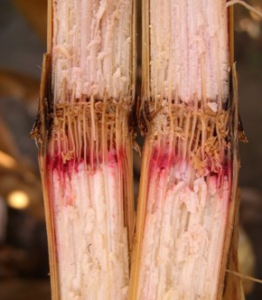Gibberella Ear Rot
Gibberella ear rot (GER) is a worldwide disease, caused by the pathogen Fusarium graminearum (Synonym Gibberella zeae), which also causes Gibberella stalk rot on corn and Fusarium head blight on wheat and barley. The mycotoxins Deoxynivalenol (DON) and Zearalenone are associated this pathogen.
Symptoms: GER is characterized by a pink to reddish mold that appears at the tip and grows down the ear. In early ear infection by the disease the entire ear may rot and be covered with a pinkish mycelium that causes the husk to tightly adhere to the ear. A superficial blue or black perithecia may cover the husk and ear shanks. The disease normally only affects a portion of the ear, except in highly susceptible hybrids.
Favorable conditions: Spores infect the plant through the silk and are most susceptible to infection 2-6 days after silk emergence. GER is more severe under cool and wet conditions after silking stages. Although infection occurs during silking, disease symptoms can keep developing after R6 until grain moisture is below 18%, especially under extended periods of rain in the fall that delay dry down. Insect damage can enhance disease infection and increase its severity.
Yield penalty: Gibberella ear rot reduces grain dry matter and consequently yield and test weight, which may reduce grain grade and price. Grains with GER may not be suitable to feed and food uses due to mycotoxin contamination.
Management: Gibberella ear rot remains in the field on plant debris and can also increase in the winter on wheat (Fusarium head blight). Therefore, cultural practices such as crop rotation and tillage can help reduce inoculum levels. Corn hybrids differ in susceptibility, those with loose husks tend to be less susceptible. Limited fungicides are currently labeled for management of this disease. It was estimated about 251.6 million bushels were lost between 2012 and 2015, across USA and Canada due to the disease (Mueller et al. 2016).
Mycotoxins: Deoxynivalenol (DON or commonly known as vomitoxin) and Zearaleonone are important mycotoxins. Animals may refuse to consume grains with DON and regurgitate consumed food. Animals that consume DON can experience infertility, abortion, and death.

